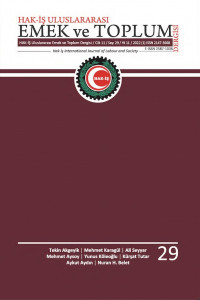FUTBOLDA BAŞARIYI ETKİLEYEN FAKTÖRLER (TÜRKİYE SÜPER LİG TAKIMLARI ÜZERİNE AMPİRİK BİR ARAŞTIRMA)
futbol, takım başarısı, takım performansı, Türkiye süper ligi
FACTORS AFFECTING SUCCESS IN FOOTBALL (AN EMPIRICAL STUDY ON TURKISH SUPER LEAGUE)
football, team success, team performance, Turkish Super League,
___
- Adler, E. S., Berry, M. J., & Doherty, D. (2013). Pushing reset: The conditional effects of coaching replacements on college football performance. Social Science Quarterly, 94 (1), 1-27.
- Matsuoka De Aragoa, M. (2015). An economic impacts of the FIFA world cup in developing countries. Honors Theses, Western Michigan University, Michigan.
- Benevides, B. I. L., Santos, S. M. D., Cabral, A. C. De A. & Ribeiro, R. A. (2015). Determinants of football games demand in Brazil and England. Global Journal of Management and Business Research: A Administra-tion and Management, 15 (10), 1-12.
- Del Corral, J., Barros, C. P., & Prieto-Rodríguez, J. (2008).The determinants of soccer player substitutions: A survival analysis of the Spanish soccer league. Journal of Sports Economics, 9 (2), 160-172.
- Dell'Osso, F. & Szymanski, S. (1991). Who are the champions? (An analysis of football and architecture). Business Strategy Review, 2 (2), 113-130.
- Fortune Turkey, (12 Şubat 2016). Türkiye'de futbol ekonomisi 1 milyar euroya yakın. www.fortuneturkey.com adresinden alındı.
- G´asquez, R. & Royuela, V. (2016). The determinants of international foot-ball success: A Panel Data Analysis of the Elo Rating. Social Science Quarterly, 97 (2), 125-141.
- García, P. C., Castro, J. A. D., & Santos, J. M. S.(2007). The economic geog-raphy of football success: Empirical evidence from european cities. Rivista Di Diritto Ed Economia Dello Sport, 3 (2), 67-88.
- Gencer, E. (2013). Teknik direktörlerin müsabaka öncesi ve devre arası maç konuşmalarının profesyonel futbolcuların performanslarına etkisi (Profesyonel futbolcu görüşleri üzerine nitel bir araştırma). Yayımlanmamış Doktora Tezi, Celal Bayar Üniversitesi Sağlık Bilimleri Enstitüsü, Manisa.
- Grazer, J. L.(2016). Identifying determinants of match performance in division I women’s collegiate soccer players. Ph.D. Thesis, East Tennessee Sta-te University, Tennessee.
- Hoffmann, R., Chew, G. L. & Bala, R. (2002). The socio-economic determinants of international soccer performance. Journal of Applied Eco-nomics, 5(2), 253-272.
- James, N. & Mellalieu, S. (2004). Possession as a performance ındicator in soccer. Journal International Journal of Performance Analysis in Sport, 4 (1), 98-102.
- Kapelman, A. E. (2013). Futbolda savunma esnasında kazanılan toplarla yapılan farklı hücum çeşitlerinin müsabaka sonucuna etkisi. Yüksek Lisans Tezi, Marmara Üniversitesi Sağlık Bilimleri Enstitüsü, İstanbul.
- Kuypers, T. (1997). The beautiful game? An econometric study of audiences, gambling and efficiency in English Football, Ph.D. Thesis, University College London, London.
- Leeds, E. M. & Leeds, M. A., (2009). International soccer success and national institutions. Journal of Sports Economics, 10 (4), 369-390.
- Mourao, P. R. & Teixeira, J. S., (2015). Gini playing soccer. Applied Economics, 47 (49), 5229–5246.
- Ozanian, M. (June 6, 2017). The world's most valuable soccer teams 2017. www.forbes.com adresinden alındı.
- Szwarc, A. (2007). Efficacy of successful and unsuccessful soccer teams taking part in finals of champions league. Research Yearbook, 13 (2), 221-225.
- Transfer Markt (a), (Mart, 2018). Avrupa ligleri ve kupa müsabakaları. www.transfermarkt.com.tr adresinden alındı.
- Transfer Markt (b), (Mart, 2018). Piyasa değerlerine göre bu müsabakada siralanmiş kulüpler. www.transfermarkt.com.tr adresinden alındı.
- Vorobyeva, A., Zarovab, E. V., Ilya Solntsevc, O., N. & Zhulevichd, V., (2016). Statistical evaluation of football performance depending on the socio-economic development of countries. Statistical Journal of the IAOS, 32 (3), 403–411.
- Wehrhahn, R. (2013). The determinants of football performance in Europe. Bachelor Thesis, Florida Atlantic University, Florida.
- Who Scored, (Mart, 2018). Futbol istatistikleri. tr.whoscored.com/Statistics adresinden alındı.
- Wikipedia (a), (Mart, 2018). 2005- 2017 AFC Champions League. www.wikipedia.com adresinden alındı.
- Wikipedia (b), (Mart, 2018). UEFA Şampiyonlar Ligi. www.wikipedia.com adresinden alındı.
- ISSN: 2147-3668
- Başlangıç: 2012
- Yayıncı: Hak-İş (Hak İşçi Sendikaları Konfederasyonu)
Mehmet Muharrem KASAPOĞLU, Sedat MURAT
FUTBOLDA BAŞARIYI ETKİLEYEN FAKTÖRLER (TÜRKİYE SÜPER LİG TAKIMLARI ÜZERİNE AMPİRİK BİR ARAŞTIRMA)
İŞ KAZASI VE MESLEK HASTALIĞINDA SİGORTALIYA SAĞLANAN YARDIMLAR
TÜRKİYE’DE GENÇ İŞSİZLİĞİ SORUNU VE ALTERNATİF ÇÖZÜM ÖNERİLERİ
Hacı Yunus TAŞ, Mahmut KÜÇÜKOĞLU, Mehmet DEMİRDÖĞMEZ
ÇOCUK YOKSULLUĞU İLE MÜCADELEDE ÜCRETSİZ OKUL YEMEĞİ: TEKİRDAĞ İLKOKULLARINDA BİR ARAŞTIRMA
GEMİ İNŞA SEKTÖRÜ ÇALIŞANLARININ GÜVENCESİZ /GEÇİCİ ÇALIŞMAYA BAKIŞLARI
TRA1 BÖLGESİNDE KADININ İŞGÜCÜNE KATILIMININ BELİRLEYİCİLERİNİN LOGİT MODEL İLE ANALİZİ
